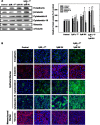Targeting met mediated epithelial-mesenchymal transition in the treatment of breast cancer
- PMID: 26932375
- PMCID: PMC4883993
- DOI: 10.1186/s40169-014-0030-5
Targeting met mediated epithelial-mesenchymal transition in the treatment of breast cancer
Abstract
Mesenchymal epithelial transition factor receptor (Met) is a receptor tyrosine kinase that plays a critical role in promoting cancer cell malignant progression. Met is activated by its ligand hepatocyte growth factor (HGF). HGF-dependent Met activation plays an important role in stimulating epithelial-mesenchymal transition (EMT) in tumor cells, resulting in increased tumor cell proliferation, survival, motility, angiogenesis, invasion, and metastasis. The HGF/Met axis has thus attracted great interest as a potential target in the development of novel cancer therapies. In an effort to suppress tumor cell malignant progression, efforts have been made to develop agents capable of inhibiting inhibit Met-induced EMT, including specific Met tyrosine kinase inhibitors, HGF antagonists that interfere with HGF binding to Met, and antibodies that prevent Met activation and/or dimerization. Tocotrienols, a subgroup within the vitamin E family of compounds, display potent anticancer activity that results, at least in part, from inhibition of HGF-dependent Met activation and signaling. The present review will provide a brief summary of the increasing importance of the HGF/Met axis as an attractive target for cancer chemotherapy and the role of tocotrienols in suppressing Met activation, signaling and HGF-induced EMT in breast cancer cells. Evidence provided suggests that γ-tocotrienol therapy may afford significant benefit in the treatment of breast cancers characterized by Met dysregulation.
Keywords: Epithelial mesenchymal transition; HGF; Met; Targeted therapy, cancer, tocotrienols.
Figures





Similar articles
-
Role of HGF/MET axis in resistance of lung cancer to contemporary management.Transl Lung Cancer Res. 2012 Sep;1(3):179-93. doi: 10.3978/j.issn.2218-6751.2012.09.04. Transl Lung Cancer Res. 2012. PMID: 25806180 Free PMC article. Review.
-
Status of Agents Targeting the HGF/c-Met Axis in Lung Cancer.Cancers (Basel). 2018 Aug 21;10(9):280. doi: 10.3390/cancers10090280. Cancers (Basel). 2018. PMID: 30134579 Free PMC article. Review.
-
Shikonin Inhibited Migration and Invasion of Human Lung Cancer Cells via Suppression of c-Met-Mediated Epithelial-to-Mesenchymal Transition.J Cell Biochem. 2017 Dec;118(12):4639-4651. doi: 10.1002/jcb.26128. Epub 2017 Jun 19. J Cell Biochem. 2017. PMID: 28485480
-
HGF/Met Signaling Is a Key Player in Malignant Mesothelioma Carcinogenesis.Biomedicines. 2014 Nov 14;2(4):327-344. doi: 10.3390/biomedicines2040327. Biomedicines. 2014. PMID: 28548074 Free PMC article. Review.
-
Curcumin inhibits epithelial-mesenchymal transition in oral cancer cells via c-Met blockade.Oncol Lett. 2020 Jun;19(6):4177-4182. doi: 10.3892/ol.2020.11523. Epub 2020 Apr 7. Oncol Lett. 2020. PMID: 32391111 Free PMC article.
Cited by
-
EMT Regulation by Autophagy: A New Perspective in Glioblastoma Biology.Cancers (Basel). 2019 Mar 6;11(3):312. doi: 10.3390/cancers11030312. Cancers (Basel). 2019. PMID: 30845654 Free PMC article. Review.
-
A Model-System to Address the Impact of Phenotypic Heterogeneity and Plasticity on the Development of Cancer Therapies.Front Oncol. 2019 Aug 29;9:842. doi: 10.3389/fonc.2019.00842. eCollection 2019. Front Oncol. 2019. PMID: 31555595 Free PMC article.
-
IFITM3 promotes malignant progression, cancer stemness and chemoresistance of gastric cancer by targeting MET/AKT/FOXO3/c-MYC axis.Cell Biosci. 2022 Aug 8;12(1):124. doi: 10.1186/s13578-022-00858-8. Cell Biosci. 2022. PMID: 35941699 Free PMC article.
-
2-Acetyl-5,8-dihydro-6-(4-methyl-3-pentenyl)-1,4-naphthohydroquinone-Derived Chalcones as Potential Anticancer Agents.Molecules. 2023 Oct 19;28(20):7172. doi: 10.3390/molecules28207172. Molecules. 2023. PMID: 37894650 Free PMC article.
-
Therapeutic Implications of Cellular Heterogeneity and Plasticity in Breast Cancer.Cell Stem Cell. 2015 Sep 3;17(3):260-71. doi: 10.1016/j.stem.2015.08.014. Cell Stem Cell. 2015. PMID: 26340526 Free PMC article. Review.
References
LinkOut - more resources
Full Text Sources
Other Literature Sources
Miscellaneous
